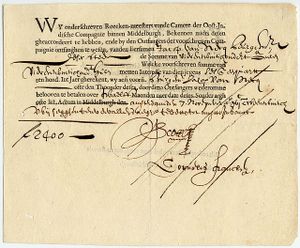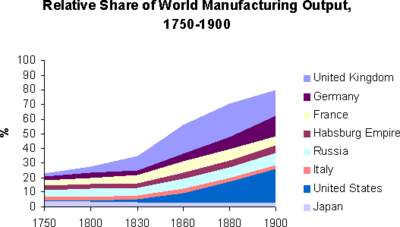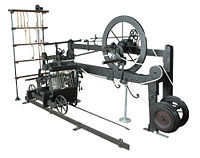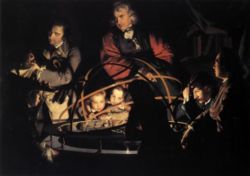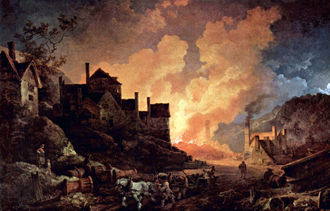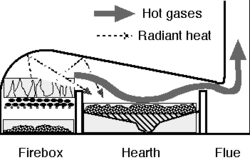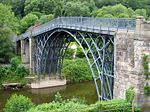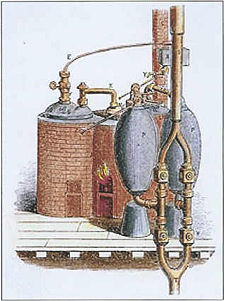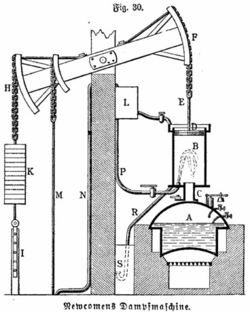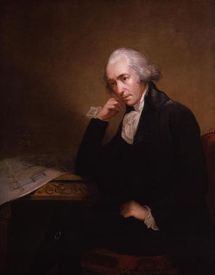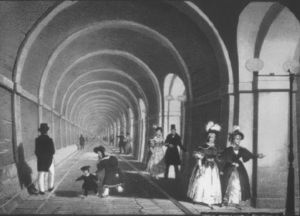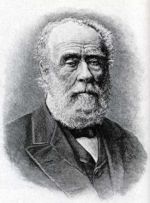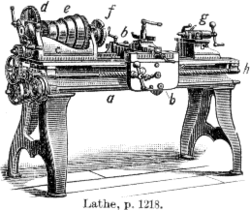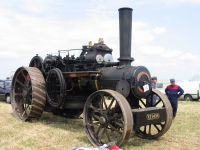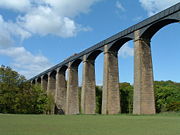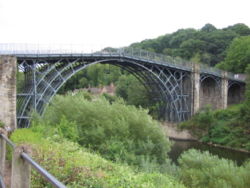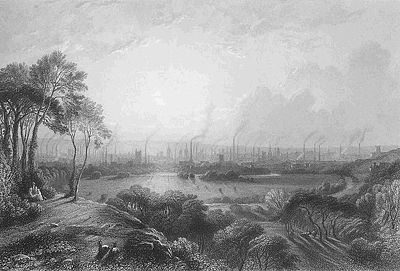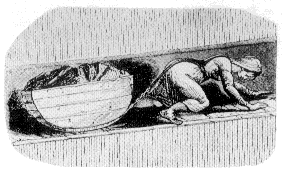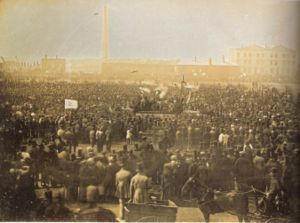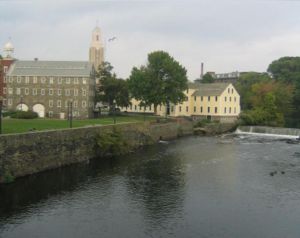Industrial Revolution
2008/9 Schools Wikipedia Selection. Related subjects: General history
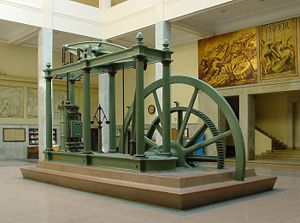
The Industrial Revolution was a period in the late 18th and early 19th centuries when major changes in agriculture, manufacturing, and transportation had a profound effect on the socioeconomic and cultural conditions in Britain. The changes subsequently spread throughout Europe and North America and eventually the world, a process that continues as industrialisation. The onset of the Industrial Revolution marked a major turning point in human society; almost every aspect of daily life was eventually influenced in some way. In the later part of the 1700s the manual labour-based economy of some parts of Great Britain began to be replaced by one dominated by the manufacture by machinery. It started with the mechanisation of the textile industries, the development of iron-making techniques and the increased use of refined coal. Trade expansion was enabled by the introduction of canals, improved roads and railways. The introduction of steam power (fuelled primarily by coal) and powered machinery (mainly in textile manufacturing) underpinned the dramatic increases in production capacity. The development of all-metal machine tools in the first two decades of the 19th century facilitated the manufacture of more production machines for manufacturing in other industries. The effects spread throughout Western Europe and North America during the 19th century, eventually affecting most of the world. The impact of this change on society was enormous.
The First Industrial Revolution, which began in the eighteenth century, merged into the Second Industrial Revolution around 1850, when technological and economic progress gained momentum with the development of steam-powered ships, railways, and later in the nineteenth century with the internal combustion engine and electrical power generation.
The period of time covered by the Industrial Revolution varies with different historians. Eric Hobsbawm held that it 'broke out' in the 1780s and was not fully felt until the 1830s or 1840s, while T. S. Ashton held that it occurred roughly between 1760 and 1830. Some twentieth century historians such as John Clapham and Nicholas Crafts have argued that the process of economic and social change took place gradually and the term revolution is not a true description of what took place. This is still a subject of debate amongst historians.
GDP per capita was broadly stable before the Industrial Revolution and the emergence of the modern capitalist economy. The Industrial Revolution began an era of per-capita economic growth in capitalist economies.
Causes
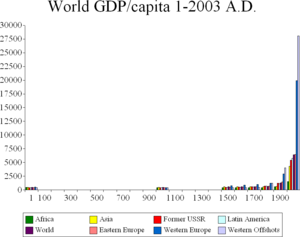
The causes of the Industrial Revolution were complicated and remain a topic for debate, with some historians feeling the Revolution as an outgrowth of social and institutional changes brought by the end of feudalism in Britain after the English Civil War in the 17th century. As national border controls became more effective, the spread of disease was lessened, therefore preventing the epidemics common in previous times. The percentage of children who lived past infancy rose significantly, leading to a larger workforce. The Enclosure movement and the British Agricultural Revolution made food production more efficient and less labour-intensive, forcing the surplus population who could no longer find employment in agriculture into cottage industry, for example weaving, and in the longer term into the cities and the newly developed factories. The colonial expansion of the 17th century with the accompanying development of international trade, creation of financial markets and accumulation of capital are also cited as factors, as is the scientific revolution of the 17th century.
Technological innovation was the heart of the Industrial Revolution and the key enabling technology was the invention and improvement of the steam engine.
Historian Lewis Mumford has proposed that the Industrial Revolution had its origins in the early Middle Ages, much earlier than most estimates. He explains that the model for standardised mass production was the printing press and that "the archetypal model for the industrial era was the clock". He also cites the monastic emphasis on order and time-keeping, as well as the fact that mediaeval cities had at their centre a church with bell ringing at regular intervals as being necessary precursors to a greater synchronisation necessary for later, more physical, manifestations such as the steam engine.
The presence of a large domestic market should also be considered an important driver of the Industrial Revolution, particularly explaining why it occurred in Britain. In other nations, such as France, markets were split up by local regions, which often imposed tolls and tariffs on goods traded amongst them.
Governments' grant of limited monopolies to inventors under a developing patent system (the Statute of Monopolies 1623) is considered an influential factor. The effects of patents, both good and ill, on the development of industrialisation are clearly illustrated in the history of the steam engine, the key enabling technology. In return for publicly revealing the workings of an invention the patent system rewards inventors by allowing, e.g, James Watt to monopolise the production of the first steam engines, thereby enabling inventors and increasing the pace of technological development. However, monopolies bring with them their own inefficiencies which may counterbalance, or even overbalance, the beneficial effects of publicising ingenuity and rewarding inventors. Watt's monopoly may have prevented other inventors, such as Richard Trevithick, William Murdoch or Jonathan Hornblower, from introducing improved steam engines thereby retarding the industrial revolution by up to 20 years.
Causes for occurrence in Europe
One question of active interest to historians is why the industrial revolution occurred in Europe and not in other parts of the world in the 18th century, particularly China, India, and the Middle East, or at other times like in Classical Antiquity or the Middle Ages. Numerous factors have been suggested, including ecology, government, and culture.
Benjamin Elman argues that China was in a high level equilibrium trap in which the non-industrial methods were efficient enough to prevent use of industrial methods with high costs of capital. Kenneth Pomeranz, in the Great Divergence, argues that Europe and China were remarkably similar in 1700, and that the crucial differences which created the Industrial Revolution in Europe were sources of coal near manufacturing centres, and raw materials such as food and wood from the New World, which allowed Europe to expand economically in a way that China could not.
However, most historians contest the assertion that Europe and China were roughly equal because modern estimates of per capita income on Western Europe in the late 18th century are of roughly 1,500 dollars in purchasing power parity (and Britain had a per capita income of nearly 2,000 dollars) whereas China, by comparison, had only 450 dollars. Also, the average interest rate was about 5% in Britain and over 30% in China, which illustrates how capital was much more abundant in Britain; capital that was available for investment.
Some historians such as David Landes and Max Weber credit the different belief systems in China and Europe with dictating where the revolution occurred. The religion and beliefs of Europe were largely products of Judaeo-Christianity, and Greek thought. Conversely, Chinese society was founded on men like Confucius, Mencius, Han Feizi ( Legalism), Lao Tzu (Taoism), and Buddha (Buddhism). The key difference between these belief systems was that those from Europe focused on the individual, while Chinese beliefs centred around relationships between people. The family unit was more important than the individual for the large majority of Chinese history, and this may have played a role in why the Industrial Revolution took much longer to occur in China. There was the additional difference as to whether people looked backwards to a reputedly glorious past for answers to their questions or looked hopefully to the future. Furthermore, Western European peoples had experienced the Renaissance, Reformation and Enlightenment; other parts of the world had not had a similar intellectual breakout, a condition that holds true even into the 21st century.
Regarding India, the Marxist historian Rajani Palme Dutt said: "The capital to finance the Industrial Revolution in India instead went into financing the Industrial Revolution in England." In contrast to China, India was split up into many competing kingdoms, with the three major ones being the Marathas, Sikhs and the Mughals. In addition, the economy was highly dependent on two sectors—agriculture of subsistence and cotton, and technical innovation was non-existent. The vast amounts of wealth were stored away in palace treasuries, and as such, were easily moved to Britain.
Causes for occurrence in Britain
The debate about the start of the Industrial Revolution also concerns the massive lead that Great Britain had over other countries. Some have stressed the importance of natural or financial resources that Britain received from its many overseas colonies or that profits from the British slave trade between Africa and the Caribbean helped fuel industrial investment. It has been pointed out, however, that slavery provided only 5% of the British national income during the years of the Industrial Revolution.
Alternatively, the greater liberalisation of trade from a large merchant base may have allowed Britain to produce and use emerging scientific and technological developments more effectively than countries with stronger monarchies, particularly China and Russia. Britain emerged from the Napoleonic Wars as the only European nation not ravaged by financial plunder and economic collapse, and possessing the only merchant fleet of any useful size (European merchant fleets having been destroyed during the war by the Royal Navy). Britain's extensive exporting cottage industries also ensured markets were already available for many early forms of manufactured goods. The conflict resulted in most British warfare being conducted overseas, reducing the devastating effects of territorial conquest that affected much of Europe. This was further aided by Britain's geographical position — an island separated from the rest of mainland Europe.
Another theory is that Britain was able to succeed in the Industrial Revolution due to the availability of key resources it possessed. It had a dense population for its small geographical size. Enclosure of common land and the related Agricultural Revolution made a supply of this labour readily available. There was also a local coincidence of natural resources in the North of England, the English Midlands, South Wales and the Scottish Lowlands. Local supplies of coal, iron, lead, copper, tin, limestone and water power, resulted in excellent conditions for the development and expansion of industry. Also, the damp, mild weather conditions of the North West of England provided ideal conditions for the spinning of cotton, providing a natural starting point for the birth of the textiles industry.
The stable political situation in Britain from around 1688, and British society's greater receptiveness to change (compared with other European countries) can also be said to be factors favouring the Industrial Revolution. In large part due to the Enclosure movement, the peasantry was destroyed as significant source of resistance to industrialisation, and the landed upper classes developed commercial interests that made them pioneers in removing obstacles to the growth of capitalism. (This point is also made in Hilaire Belloc's The Servile State.)
Protestant work ethic
Another theory is that the British advance was due to the presence of an entrepreneurial class which believed in progress, technology and hard work. The existence of this class is often linked to the Protestant work ethic (see Max Weber) and the particular status of the Baptists and the dissenting Protestant sects, such as the Quakers and Presbyterians that had flourished with the English Civil War. Reinforcement of confidence in the rule of law, which followed establishment of the prototype of constitutional monarchy in Britain in the Glorious Revolution of 1688, and the emergence of a stable financial market there based on the management of the national debt by the Bank of England, contributed to the capacity for, and interest in, private financial investment in industrial ventures.
Dissenters found themselves barred or discouraged from almost all public offices, as well as education at England's only two universities at the time (although dissenters were still free to study at Scotland's four universities). When the restoration of the monarchy took place and membership in the official Anglican Church became mandatory due to the Test Act, they thereupon became active in banking, manufacturing and education. The Unitarians, in particular, were very involved in education, by running Dissenting Academies, where, in contrast to the universities of Oxford and Cambridge and schools such as Eton and Harrow, much attention was given to mathematics and the sciences —areas of scholarship vital to the development of manufacturing technologies.
Historians sometimes consider this social factor to be extremely important, along with the nature of the national economies involved. While members of these sects were excluded from certain circles of the government, they were considered fellow Protestants, to a limited extent, by many in the middle class, such as traditional financiers or other businessmen. Given this relative tolerance and the supply of capital, the natural outlet for the more enterprising members of these sects would be to seek new opportunities in the technologies created in the wake of the scientific revolution of the 17th century.
Innovations
The commencement of the Industrial Revolution is closely linked to a small number of innovations, made in the second half of the 18th century:
- Textiles - Cotton spinning using Richard Arkwright's water frame, James Hargreaves's Spinning Jenny, and Samuel Crompton's Spinning Mule (a combination of the Spinning Jenny and the Water Frame). This was patented in 1769 and so came out of patent in 1783. The end of the patent was rapidly followed by the erection of many cotton mills. Similar technology was subsequently applied to spinning worsted yarn for various textiles and flax for linen.
- Steam power - The improved steam engine invented by James Watt was initially mainly used for pumping out mines, but from the 1780s was applied to power machines. This enabled rapid development of efficient semi-automated factories on a previously unimaginable scale in places where waterpower was not available.
- Iron founding - In the Iron industry, coke was finally applied to all stages of iron smelting, replacing charcoal. This had been achieved much earlier for lead and copper as well as for producing pig iron in a blast furnace, but the second stage in the production of bar iron depended on the use of potting and stamping (for which a patent expired in 1786) or puddling (patented by Henry Cort in 1783 and 1784).
These represent three 'leading sectors', in which there were key innovations, which allowed the economic take off by which the Industrial Revolution is usually defined. This is not to belittle many other inventions, particularly in the textile industry. Without some earlier ones, such as spinning jenny and flying shuttle in the textile industry and the smelting of pig iron with coke, these achievements might have been impossible. Later inventions such as the power loom and Richard Trevithick's high pressure steam engine were also important in the growing industrialisation of Britain. The application of steam engines to powering cotton mills and ironworks enabled these to be built in places that were most convenient because other resources were available, rather than where there was water to power a mill.
In the textile sector, such mills became the model for the organisation of human labour in factories, epitomised by Cottonopolis, the name given to the vast collection of cotton mills, factories and administration offices based in Manchester. The assembly line system greatly improved efficiency, both in this and other industries. With a series of men trained to do a single task on a product, then having it moved along to the next worker, the number of finished goods also rose significantly.
Also important was the 1756 rediscovery of concrete (based on hydraulic lime mortar) by the British engineer John Smeaton, which had been lost for 13 centuries.
Transfer of knowledge
Knowledge of new innovation was spread by several means. Workers who were trained in the technique might move to another employer or might be poached. A common method was for someone to make a study tour, gathering information where he could. During the whole of the Industrial Revolution and for the century before, all European countries and America engaged in study-touring; some nations, like Sweden and France, even trained civil servants or technicians to undertake it as a matter of state policy. In other countries, notably Britain and America, this practice was carried out by individual manufacturers anxious to improve their own methods. Study tours were common then, as now, as was the keeping of travel diaries. Records made by industrialists and technicians of the period are an incomparable source of information about their methods.
Another means for the spread of innovation was by the network of informal philosophical societies, like the Lunar Society of Birmingham, in which members met to discuss 'natural philosophy' (i.e. science) and often its application to manufacturing. The Lunar Society flourished from 1765 to 1809, and it has been said of them, "They were, if you like, the revolutionary committee of that most far reaching of all the eighteenth century revolutions, the Industrial Revolution". Other such societies published volumes of proceedings and transactions. For example, the London-based Royal Society of Arts published an illustrated volume of new inventions, as well as papers about them in its annual Transactions.
There were publications describing technology. Encyclopaedias such as Harris's Lexicon Technicum (1704) and Dr Abraham Rees's Cyclopaedia (1802-1819) contain much of value. Cyclopaedia contains an enormous amount of information about the science and technology of the first half of the Industrial Revolution, very well illustrated by fine engravings. Foreign printed sources such as the Descriptions des Arts et Métiers and Diderot's Encyclopédie explained foreign methods with fine engraved plates.
Periodical publications about manufacturing and technology began to appear in the last decade of the 18th century, and many regularly included notice of the latest patents. Foreign periodicals, such as the Annales des Mines, published accounts of travels made by French engineers who observed British methods on study tours.
Technological developments in Britain
Textile manufacture
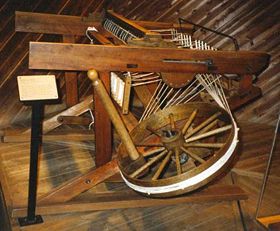
In the early 18th century, British textile manufacture was based on wool which was processed by individual artisans, doing the spinning and weaving on their own premises. This system is called a cottage industry. Flax and cotton were also used for fine materials, but the processing was difficult because of the pre-processing needed, and thus goods in these materials made only a small proportion of the output.
Use of the spinning wheel and hand loom restricted the production capacity of the industry, but incremental advances increased productivity to the extent that manufactured cotton goods became the dominant British export by the early decades of the 19th century. India was displaced as the premier supplier of cotton goods.
Lewis Paul patented the Roller Spinning machine and the flyer-and-bobbin system for drawing wool to a more even thickness, developed with the help of John Wyatt in Birmingham. Paul and Wyatt opened a mill in Birmingham which used their new rolling machine powered by a donkey. In 1743, a factory was opened in Northampton with fifty spindles on each of five of Paul and Wyatt's machines. This operated until about 1764. A similar mill was built by Daniel Bourn in Leominster, but this burnt down. Both Lewis Paul and Daniel Bourn patented carding machines in 1748. Using two sets of rollers that travelled at different speeds, it was later used in the first cotton spinning mill. Lewis's invention was later developed and improved by Richard Arkwright in his water frame and Samuel Crompton in his spinning mule.
Other inventors increased the efficiency of the individual steps of spinning (carding, twisting and spinning, and rolling) so that the supply of yarn increased greatly, which fed a weaving industry that was advancing with improvements to shuttles and the loom or 'frame'. The output of an individual labourer increased dramatically, with the effect that the new machines were seen as a threat to employment, and early innovators were attacked and their inventions destroyed.
To capitalise upon these advances, it took a class of entrepreneurs, of which the most famous is Richard Arkwright. He is credited with a list of inventions, but these were actually developed by people such as Thomas Highs and John Kay; Arkwright nurtured the inventors, patented the ideas, financed the initiatives, and protected the machines. He created the cotton mill which brought the production processes together in a factory, and he developed the use of power — first horse power and then water power — which made cotton manufacture a mechanised industry. Before long steam power was applied to drive textile machinery.
Metallurgy
The major change in the metal industries during the era of the Industrial Revolution was the replacement of organic fuels based on wood with fossil fuel based on coal. Much of this happened somewhat before the Industrial Revolution, based on innovations by Sir Clement Clerke and others from 1678, using coal reverberatory furnaces known as cupolas. These were operated by the flames, which contained carbon monoxide, playing on the ore and reducing the oxide to metal. This has the advantage that impurities (such as sulphur) in the coal do not migrate into the metal. This technology was applied to lead from 1678 and to copper from 1687. It was also applied to iron foundry work in the 1690s, but in this case the reverberatory furnace was known as an air furnace. The foundry cupola is a different (and later) innovation.
This was followed by Abraham Darby, who made great strides using coke to fuel his blast furnaces at Coalbrookdale in 1709. However, the coke pig iron he made was used mostly for the production of cast iron goods such as pots and kettles. He had the advantage over his rivals in that his pots, cast by his patented process, were thinner and cheaper than theirs. Coke pig iron was hardly used to produce bar iron in forges until the mid 1750s, when his son Abraham Darby II built Horsehay and Ketley furnaces (not far from Coalbrookdale). By then, coke pig iron was cheaper than charcoal pig iron.
Bar iron for smiths to forge into consumer goods was still made in finery forges, as it long had been. However, new processes were adopted in the ensuing years. The first is referred to today as potting and stamping, but this was superseded by Henry Cort's puddling process. From 1785, perhaps because the improved version of potting and stamping was about to come out of patent, a great expansion in the output of the British iron industry began. The new processes did not depend on the use of charcoal at all and were therefore not limited by charcoal sources.
Up to that time, British iron manufacturers had used considerable amounts of imported iron to supplement native supplies. This came principally from Sweden from the mid 17th century and later also from Russia from the end of the 1720s. However, from 1785, imports decreased because of the new iron making technology, and Britain became an exporter of bar iron as well as manufactured wrought iron consumer goods.
Since iron was becoming cheaper and more plentiful, it also became a major structural material following the building of the innovative The Iron Bridge in 1778 by Abraham Darby III.
An improvement was made in the production of steel, which was an expensive commodity and used only where iron would not do, such as for the cutting edge of tools and for springs. Benjamin Huntsman developed his crucible steel technique in the 1740s. The raw material for this was blister steel, made by the cementation process.
The supply of cheaper iron and steel aided the development of boilers and steam engines, and eventually railways. Improvements in machine tools allowed better working of iron and steel and further boosted the industrial growth of Britain.
Mining
Coal mining in Britain, particularly in South Wales started early. Before the steam engine, pits were often shallow bell pits following a seam of coal along the surface, which were abandoned as the coal was extracted. In other cases, if the geology was favourable, the coal was mined by means of an adit or drift mine driven into the side of a hill. Shaft mining was done in some areas, but the limiting factor was the problem of removing water. It could be done by hauling buckets of water up the shaft or to a sough (a tunnel driven into a hill to drain a mine). In either case, the water had to be discharged into a stream or ditch at a level where it could flow away by gravity. The introduction of the steam engine greatly facilitated the removal of water and enabled shafts to be made deeper, enabling more coal to be extracted. These were developments that had begun before the Industrial Revolution, but the adoption of James Watt's more efficient steam engine from the 1770s reduced the fuel costs of engines, making mines more profitable. Coal mining was very dangerous owing to the presence of firedamp in many coal seams. Some degree of safety was provided by the safety lamp which was invented in 1816 by Sir Humphrey Davy and independently by George Stephenson. However, the lamps proved a false dawn because they became unsafe very quickly and provided a weak light. Firedamp explosions continued , often setting off coal dust explosions, so casualties grew during the entire nineteenth century. Conditions of work were very poor, with a high casualty rate from rock falls.
Steam power
The development of the stationary steam engine was an essential early element of the Industrial Revolution; however, for most of the period of the Industrial Revolution, the majority of industries still relied on wind and water power as well as horse and man-power for driving small machines.
The first real attempt at industrial use of steam power was due to Thomas Savery in 1698. He constructed and patented in London a low-lift combined vacuum and pressure water pump, that generated about one horsepower (hp) and was used as in numerous water works and tried in a few mines (hence its "brand name", The miner's Friend), but it was not a success since it was limited in pumping height and prone to boiler explosions.
The first safe and successful steam power plant was introduced by Thomas Newcomen from 1719. Newcomen apparently conceived his machine quite independently of Savery, but as the latter had taken out a very wide-ranging patent, Newcomen and his associates were obliged to come to an arrangement with him, marketing the engine until 1733 under a joint patent. Newcomen's engine appears to have been based on Papin's experiments carried out 30 years earlier, and employed a piston and cylinder, one end of which was open to the atmosphere above the piston. Steam just above atmospheric pressure (all that the boiler could stand) was introduced into the lower half of the cylinder beneath the piston during the gravity-induced upstroke; the steam was then condensed by a jet of cold water injected into the steam space to produce a partial vacuum; the pressure differential between the atmosphere and the vacuum on either side of the piston displaced it downwards into the cylinder, raising the opposite end of a rocking beam to which was attached a gang of gravity-actuated reciprocating force pumps housed in the mineshaft. The engine's downward power stroke raised the pump, priming it and preparing the pumping stroke. At first the phases were controlled by hand, but within ten years an escapement mechanism had been devised worked by of a vertical plug tree suspended from the rocking beam which rendered the engine self-acting.
A number of Newcomen engines were successfully put to use in Britain for draining hitherto unworkable deep mines, with the engine on the surface; these were large machines, requiring a lot of capital to build, and produced about 5 hp (3.7 kW). They were extremely inefficient by modern standards, but when located where coal was cheap at pit heads, opened up a great expansion in coal mining by allowing mines to go deeper. Despite their disadvantages, Newcomen engines were reliable and easy to maintain and continued to be used in the coalfields until the early decades of the nineteenth century. By 1729, when Newcomen died, his engines had spread (first) to Hungary in 1722 ,Germany, Austria, and Sweden. A total of 110 are known to have been built by 1733 when the joint patent expired, of which 14 were abroad. In the 1770s, the engineer John Smeaton built some very large examples and introduced a number of improvements. A total of 1,454 engines had been built by 1800.
A fundamental change in working principles was brought about by James Watt. With the close collaboration Matthew Boulton, he had succeeded by 1778 in perfecting his steam engine, which incorporated a series of radical improvements, notably the closing off of the upper part of the cylinder thereby making the low pressure steam drive the top of the piston instead of the atmosphere, use of a steam jacket and the celebrated separate steam condenser chamber. All this meant that a more constant temperature could be maintained in the cylinder and that engine efficiency no longer varied according to atmospheric conditions. These improvements increased engine efficiency by a factor of about five, saving 75% on coal costs.
Nor could the atmospheric engine be easily adapted to drive a rotating wheel, although Wasborough and Pickard did succeed in doing so towards 1780. However by 1783 the more economical Watt steam engine had been fully developed into a double-acting rotative type, which meant that it could be used to directly drive the rotary machinery of a factory or mill. Both of Watt's basic engine types were commercially very successful, and by 1800, the firm Boulton & Watt had constructed 496 engines, with 164 driving reciprocating pumps, 24 serving blast furnaces, and 308 powering mill machinery; most of the engines generated from 5 to 10 hp (7.5 kW).
The development of machine tools, such as the lathe, planing and shaping machines powered by these engines, enabled all the metal parts of the engines to be easily and accurately cut and in turn made it possible to build larger and more powerful engines.
Until about 1800, the most common pattern of steam engine was the beam engine, built as an integral part of a stone or brick engine-house, but soon various patterns of self-contained portative engines (readily removable, but not on wheels) were developed, such as the table engine. Towards the turn of the 19th century, the Cornish engineer Richard Trevithick, and the American, Oliver Evans began to construct higher pressure non-condensing steam engines, exhausting against the atmosphere. This allowed an engine and boiler to be combined into a single unit compact enough to be used on mobile road and rail locomotives and steam boats.
In the early 19th century after the expiration of Watt's patent, the steam engine underwent many improvements by a host of inventors and engineers.
Chemicals
The large scale production of chemicals was an important development during the Industrial Revolution. The first of these was the production of sulphuric acid by the lead chamber process invented by the Englishman John Roebuck (James Watt's first partner) in 1746. He was able to greatly increase the scale of the manufacture by replacing the relatively expensive glass vessels formerly used with larger, less expensive chambers made of riveted sheets of lead. Instead of a few pounds at a time, he was able to make a hundred pounds (45 kg) or so at a time in each of the chambers.
The production of an alkali on a large scale became an important goal as well, and Nicolas Leblanc succeeded in 1791 in introducing a method for the production of sodium carbonate. The Leblanc process was a reaction of sulphuric acid with sodium chloride to give sodium sulphate and hydrochloric acid. The sodium sulphate was heated with limestone (calcium carbonate) and coal to give a mixture of sodium carbonate and calcium sulphide. Adding water separated the soluble sodium carbonate from the calcium sulphide. The process produced a large amount of pollution (the hydrochloric acid was initially vented to the air, and calcium sulphide was a useless waste product). Nonetheless, this synthetic soda ash proved economical compared to that from burning certain plants ( barilla) or from kelp, which were the previously dominant sources of soda ash, and also to potash ( potassium carbonate) derived from hardwood ashes.
These two chemicals were very important because they enabled the introduction of a host of other inventions, replacing many small-scale operations with more cost-effective and controllable processes. Sodium carbonate had many uses in the glass, textile, soap, and paper industries. Early uses for sulphuric acid included pickling (removing rust) iron and steel, and for bleaching cloth.
The development of bleaching powder ( calcium hypochlorite) by Scottish chemist Charles Tennant in about 1800, based on the discoveries of French chemist Claude Louis Berthollet, revolutionised the bleaching processes in the textile industry by dramatically reducing the time required (from months to days) for the traditional process then in use, which required repeated exposure to the sun in bleach fields after soaking the textiles with alkali or sour milk. Tennant's factory at St Rollox, North Glasgow, became the largest chemical plant in the world.
In 1824 Joseph Aspdin, a British brick layer turned builder, patented a chemical process for making portland cement which was an important advance in the building trades. This process involves sintering a mixture of clay and limestone to about 1400 °C, then grinding it into a fine powder which is then mixed with water, sand and gravel to produce concrete. Portland cement was used by the famous English engineer Marc Isambard Brunel several years later when constructing the Thames Tunnel. Cement was used on a large scale in the construction of the London sewerage system a generation later.
Machine tools
The Industrial Revolution could not have developed without machine tools, for they enabled manufacturing machines to be made. They have their origins in the tools developed in the 18th century by makers of clocks and watches and scientific instrument makers to enable them to batch-produce small mechanisms. The mechanical parts of early textile machines were sometimes called 'clock work' because of the metal spindles and gears they incorporated. The manufacture of textile machines drew craftsmen from these trades and is the origin of the modern engineering industry.
Machines were built by various craftsmen— carpenters made wooden framings, and smiths and turners made metal parts. A good example of how machine tools changed manufacturing took place in Birmingham, England, in 1830. The invention of a new machine by William Joseph Gillott, William Mitchell and James Stephen Perry allowed mass manufacture of robust, cheap steel pen nibs; the process had been laborious and expensive. Because of the difficulty of manipulating metal and the lack of machine tools, the use of metal was kept to a minimum. Wood framing had the disadvantage of changing dimensions with temperature and humidity, and the various joints tended to rack (work loose) over time. As the Industrial Revolution progressed, machines with metal frames became more common, but they required machine tools to make them economically. Before the advent of machine tools, metal was worked manually using the basic hand tools of hammers, files, scrapers, saws and chisels. Small metal parts were readily made by this means, but for large machine parts, production was very laborious and costly.
Apart from workshop lathes used by craftsmen, the first large machine tool was the cylinder boring machine used for boring the large-diameter cylinders on early steam engines. The planing machine, the slotting machine and the shaping machine were developed in the first decades of the 19th century. Although the milling machine was invented at this time, it was not developed as a serious workshop tool until during the Second Industrial Revolution.
Military production had a hand in the development of machine tools. Henry Maudslay, who trained a school of machine tool makers early in the 19th century, was employed at the Royal Arsenal, Woolwich, as a young man where he would have seen the large horse-driven wooden machines for cannon boring made and worked by the Verbruggans. He later worked for Joseph Bramah on the production of metal locks, and soon after he began working on his own. He was engaged to build the machinery for making ships' pulley blocks for the Royal Navy in the Portsmouth Block Mills. These were all metal and were the first machines for mass production and making components with a degree of interchangeability. The lessons Maudslay learned about the need for stability and precision he adapted to the development of machine tools, and in his workshops he trained a generation of men to build on his work, such as Richard Roberts, Joseph Clement and Joseph Whitworth.
James Fox of Derby had a healthy export trade in machine tools for the first third of the century, as did Matthew Murray of Leeds. Roberts was a maker of high-quality machine tools and a pioneer of the use of jigs and gauges for precision workshop measurement.
Gas lighting
Another major industry of the later Industrial Revolution was gas lighting. Though others made a similar innovation elsewhere, the large scale introduction of this was the work of William Murdoch, an employee of Boulton and Watt, the Birmingham steam engine pioneers. The process consisted of the large scale gasification of coal in furnaces, the purification of the gas (removal of sulphur, ammonium, and heavy hydrocarbons), and its storage and distribution. The first gaslighting utilities were established in London between 1812-20. They soon became one of the major consumers of coal in the UK. Gaslighting had in impact on social and industrial organisation because it allowed factories and stores to remain open longer than with tallow candles or oil. Its introduction allowed night life to flourish in cities and towns as interiors and street could be lighted on a larger scale than before.
Glass making
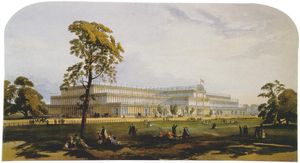
A new method of producing glass, known as the cylinder process, was developed in Europe during the early 19th century. In 1832, this process was used by the Chance Brothers to create sheet glass. They became the leading producers of window and plate glass. This advancement allowed for larger panes of glass to be created without interruption, thus freeing up the space planning in interiors as well as the fenestration of buildings. The crystal palace is the supreme example of the use of sheet glass in a new and innovative structure.
Agriculture
In the mid nineteenth century John Fowler, an engineer and inventor, began to look at the possibility of using steam engines for ploughing and digging drainage channels. The system that he invented involved either a single stationary engine at the corner of a field drawing a plough via sets of winches and pulleys, or two engines placed at either end of a field drawing the plough backwards and forwards between them by means of a cable attached to winches. Fowler's ploughing system vastly reduced the cost of ploughing farmland compared with horse-drawn ploughs. Also his ploughing system, when used for digging drainage channels, made possible the cultivation of previously unusable swampy land. The traction engine later became a common sight in working threshing machines during haymaking time and ploughing fields.
Transport in Britain
At the beginning of the Industrial Revolution, inland transport was by navigable rivers and roads, with coastal vessels employed to move heavy goods by sea. Railways or wagon ways were used for conveying coal to rivers for further shipment, but canals had not yet been constructed. Animals supplied all of the motive power on land, with sails providing the motive power on the sea.
The Industrial Revolution improved Britain's transport infrastructure with a turnpike road network, a canal, and waterway network, and a railway network. Raw materials and finished products could be moved more quickly and cheaply than before. Improved transportation also allowed new ideas to spread quickly.
Coastal sail
Sailing vessels had long been used for moving goods round the British coast. The trade transporting coal to London from Newcastle had begun in mediaeval times. The major international seaports such as London, Bristol, and Liverpool, were the means by which raw materials such as cotton might be imported and finished goods exported. Transporting goods onwards within Britain by sea was common during the whole of the Industrial Revolution and only fell away with the growth of the railways at the end of the period.
Navigable rivers
All the major rivers of the United Kingdom were navigable during the Industrial Revolution. Some were anciently navigable, notably the Severn, Thames, and Trent. Some were improved, or had navigation extended upstream, but usually in the period before the Industrial Revolution, rather than during it.
The Severn, in particular, was used for the movement of goods to the Midlands which had been imported into Bristol from abroad, and for the export of goods from centres of production in Shropshire (such as iron goods from Coalbrookdale) and the Black Country. Transport was by way of trows—small sailing vessels which could pass the various shallows and bridges in the river. The trows could navigate the Bristol Channel to the South Wales ports and Somerset ports, such as Bridgwater and even as far as France.
Canals
Canals began to be built in the late eighteenth century to link the major manufacturing centres in the Midlands and north with seaports and with London, at that time itself the largest manufacturing centre in the country. Canals were the first technology to allow bulk materials to be easily transported across country. A single canal horse could pull a load dozens of times larger than a cart at a faster pace. By the 1820s, a national network was in existence. Canal construction served as a model for the organisation and methods later used to construct the railways. They were eventually largely superseded as profitable commercial enterprises by the spread of the railways from the 1840s on.
Britain's canal network, together with its surviving mill buildings, is one of the most enduring features of the early Industrial Revolution to be seen in Britain.
Roads
Much of the original British road system was poorly maintained by thousands of local parishes, but from the 1720s (and occasionally earlier) turnpike trusts were set up to charge tolls and maintain some roads. Increasing numbers of main roads were turnpiked from the 1750s to the extent that almost every main road in England and Wales was the responsibility of some turnpike trust. New engineered roads were built by John Metcalf, Thomas Telford and John Macadam. The major turnpikes radiated from London and were the means by which the Royal Mail was able to reach the rest of the country. Heavy goods transport on these roads was by means of slow, broad wheeled, carts hauled by teams of horses. Lighter goods were conveyed by smaller carts or by teams of pack horse. Stage coaches carried the rich, and the less wealthy could pay to ride on carriers carts.
Railways

Wagonways for moving coal in the mining areas had started in the 17th century and were often associated with canal or river systems for the further movement of coal. These were all horse drawn or relied on gravity, with a stationary steam engine to haul the wagons back to the top of the incline. The first applications of the steam locomotive were on wagon or plate ways (as they were then often called from the cast iron plates used). Horse-drawn public railways did not begin until the early years of the 19th century. Steam-hauled public railways began with the Stockton and Darlington Railway in 1825 and the Liverpool and Manchester Railway in 1830. Construction of major railways connecting the larger cities and towns began in the 1830s but only gained momentum at the very end of the first Industrial Revolution.
After many of the workers had completed the railways, they did not return to their rural lifestyles but instead remained in the cities, providing additional workers for the factories.
Railways helped Britain's trade enormously, providing a quick and easy way of transport.
Social effects
In terms of social structure, the Industrial Revolution witnessed the triumph of a middle class of industrialists and businessmen over a landed class of nobility and gentry.
Ordinary working people found increased opportunities for employment in the new mills and factories, but these were often under strict working conditions with long hours of labour dominated by a pace set by machines. However, harsh working conditions were prevalent long before the Industrial Revolution took place. Pre-industrial society was very static and often cruel—child labour, dirty living conditions and long working hours were just as prevalent before the Industrial Revolution.
Factories and urbanisation
Industrialisation led to the creation of the factory. Arguably the first was John Lombe's water-powered silk mill at Derby, operational by 1721. However, the rise of the factory came somewhat later when cotton spinning was mechanised.
The factory system was largely responsible for the rise of the modern city, as large numbers of workers migrated into the cities in search of employment in the factories. Nowhere was this better illustrated than the mills and associated industries of Manchester, nicknamed " Cottonopolis", and arguably the world's first industrial city. For much of the 19th century, production was done in small mills, which were typically water-powered and built to serve local needs. Later each factory would have its own steam engine and a chimney to give an efficient draft through its boiler.
The transition to industrialisation was not without difficulty. For example, a group of English workers known as Luddites formed to protest against industrialisation and sometimes sabotaged factories.
In other industries the transition to factory production was not so divisive. Some industrialists themselves tried to improve factory and living conditions for their workers. One of the earliest such reformers was Robert Owen, known for his pioneering efforts in improving conditions for workers at the New Lanark mills, and often regarded as one of the key thinkers of the early socialist movement.
By 1746, an integrated brass mill was working at Warmley near Bristol. Raw material went in at one end, was smelted into brass and was turned into pans, pins, wire, and other goods. Housing was provided for workers on site. Josiah Wedgwood and Matthew Boulton were other prominent early industrialists, who employed the factory system.
Child labour
The Industrial Revolution led to a population increase, but the chance of surviving childhood did not improve throughout the industrial revolution (although infant mortality rates were improved markedly). There was still limited opportunity for education, and children were expected to work. Employers could pay a child less than an adult even though their productivity was comparable; there was no need for strength to operate an industrial machine, and since the industrial system was completely new there were no experienced adult labourers. This made child labour the labour of choice for manufacturing in the early phases of the Industrial Revolution between the 18th and 19th centuries.
Child labour had existed before the Industrial Revolution, but with the increase in population and education it became more visible. Before the passing of laws protecting children, many were forced to work in terrible conditions for much lower pay than their elders.
Reports were written detailing some of the abuses, particularly in the coal mines and textile factories and these helped to popularise the children's plight. The public outcry, especially among the upper and middle classes, helped stir change in the young workers' welfare.
Politicians and the government tried to limit child labour by law, but factory owners resisted; some felt that they were aiding the poor by giving their children money to buy food to avoid starvation, and others simply welcomed the cheap labour. In 1833 and 1844, the first general laws against child labour, the Factory Acts, were passed in England: Children younger than nine were not allowed to work, children were not permitted to work at night, and the work day of youth under the age of 18 was limited to twelve hours. Factory inspectors supervised the execution of the law. About ten years later, the employment of children and women in mining was forbidden. These laws decreased the number of child labourers; however, child labour remained in Europe up to the 20th century.
Housing
Living conditions during the Industrial Revolution varied from the splendour of the homes of the owners to the squalor of the lives of the workers. Cliffe Castle, Keighley, is a good example of how the newly rich chose to live. This is a large home modelled loosely on a castle with towers and garden walls. The home is very large and was surrounded by a massive garden, the Cliffe Castle is now open to the public as a museum.
Poor people lived in very small houses in cramped streets. These homes would share toilet facilities, have open sewers and would be at risk of damp. Disease was spread through a contaminated water supply. Conditions did improve during the 19th century as public health acts were introduced covering things such as sewage, hygiene and making some boundaries upon the construction of homes. Not everybody lived in homes like these. The Industrial Revolution created a larger middle class of professionals such as lawyers and doctors. The conditions for the poor improved over the course of the 19th century because of government and local plans which led to cities becoming cleaner places, but life had not been easy for the poor before industrialisation. However, as a result of the Revolution, huge numbers of the working class died due to diseases spreading through the cramped living conditions. Chest diseases from the mines, cholera from polluted water and typhoid were also extremely common, as was smallpox. Accidents in factories with child and female workers were regular. Dickens' novels perhaps best illustrate this; even some government officials were horrified by what they saw. Strikes and riots by workers were also relatively common.
Luddites
The rapid industrialisation of the English economy cost many craft workers their jobs. The movement started first with lace and hosiery workers near Nottingham and spread to other areas of the textile industry owing to early industrialisation. Many weavers also found themselves suddenly unemployed since they could no longer compete with machines which only required relatively limited (and unskilled) labour to produce more cloth than a single weaver. Many such unemployed workers, weavers and others, turned their animosity towards the machines that had taken their jobs and began destroying factories and machinery. These attackers became known as Luddites, supposedly followers of Ned Ludd, a folklore figure. The first attacks of the Luddite movement began in 1811. The Luddites rapidly gained popularity, and the British government took drastic measures using the militia or army to protect industry. Those rioters who were caught were tried and hanged, or transported for life.
Unrest continued in other sectors as they industrialised, such as agricultural labourers in the 1830s, when large parts of southern Britain were affected by the Captain Swing disturbances. Threshing machines were a particular target, and rick burning was a popular activity. The riots led however, to the first formation of trade unions, and further pressure for reform.
Organisation of labour
The Industrial Revolution concentrated labour into mills, factories and mines, thus facilitating the organisation of combinations or trade unions to help advance the interests of working people. The power of a union could demand better terms by withdrawing all labour and causing a consequent cessation of production. Employers had to decide between giving in to the union demands at a cost to themselves or suffer the cost of the lost production. Skilled workers were hard to replace, and these were the first groups to successfully advance their conditions through this kind of bargaining.
The main method the unions used to effect change was strike action. Many strikes were painful events for both sides, the unions and the management. In England, the Combination Act forbade workers to form any kind of trade union from 1799 until its repeal in 1824. Even after this, unions were still severely restricted.
In 1832, the year of the Reform Act which extended the vote in England but did not grant universal suffrage, six men from Tolpuddle in Dorset founded the Friendly Society of Agricultural Labourers to protest against the gradual lowering of wages in the 1830s. They refused to work for less than 10 shillings a week, although by this time wages had been reduced to seven shillings a week and were due to be further reduced to six shillings. In 1834 James Frampton, a local landowner, wrote to the Prime Minister, Lord Melbourne, to complain about the union, invoking an obscure law from 1797 prohibiting people from swearing oaths to each other, which the members of the Friendly Society had done. James Brine, James Hammett, George Loveless, George's brother James Loveless, George's brother in-law Thomas Standfield, and Thomas's son John Standfield were arrested, found guilty, and transported to Australia. They became known as the Tolpuddle martyrs. In the 1830s and 1840s the Chartist movement was the first large scale organised working class political movement which campaigned for political equality and social justice. Its Charter of reforms received over three million signatures but was rejected by Parliament without consideration.
Working people also formed friendly societies and co-operative societies as mutual support groups against times of economic hardship. Enlightened industrialists, such as Robert Owen also supported these organisations to improve the conditions of the working class.
Unions slowly overcame the legal restrictions on the right to strike. In 1842, a General Strike involving cotton workers and colliers was organised through the Chartist movement which stopped production across Great Britain.
Eventually effective political organisation for working people was achieved through the trades unions who, after the extensions of the franchise in 1867 and 1885, began to support socialist political parties that later merged to became the British Labour Party.
Other effects
The application of steam power to the industrial processes of printing supported a massive expansion of newspaper and popular book publishing, which reinforced rising literacy and demands for mass political participation.
During the Industrial Revolution, the life expectancy of children increased dramatically. The percentage of the children born in London who died before the age of five decreased from 74.5% in 1730 - 1749 to 31.8% in 1810 - 1829. Also, there was a significant increase in worker wages during the period 1813-1913.
Industrial Revolution elsewhere
United States
As in Britain, the United States originally used water power to run its factories, with the consequence that industrialisation was essentially limited to New England and the rest of the Northeastern United States, where fast-moving rivers were located. However, the raw materials (cotton) came from the Southern United States. It was not until after the American Civil War in the 1860s that steam-powered manufacturing overtook water-powered manufacturing, allowing the industry to fully spread across the nation.
Samuel Slater (1768–1835) is popularly known as the founder of the American cotton industry. As a boy apprentice in Derbyshire, England he learnt of the new techniques in the textile industry and defied laws against the emigration of skilled workers by leaving for New York in 1789, hoping to make money with his knowledge. Slater started Slater's mill at Pawtucket, Rhode Island, in 1793 and went on to own thirteen textile mills. Daniel Day established a wool carding mill in the Blackstone Valley at Uxbridge, Massachusetts in 1810, the third woollen mill established in the U.S. (The first was in Hartford, CT, and the second at Watertown, MA). The John H. Chafee Blackstone River Valley National Heritage Corridor retraces the history of "America's Hardest working River', the Blackstone. The Blackstone River and its tributaries, which cover more than 45 miles (72 km) from Worcester to Providence, was the birthplace of America's Industrial Revolution. At its peak over 1100 mills operated in this valley, including Slater's mill, and with it the earliest beginnings of America's Industrial and Technological Development. (see also Blackstone River Valley National Heritage Corridor)
While on a trip to England in 1810, Newburyport, Massachusetts merchant Francis Cabot Lowell was allowed to tour the British textile factories, but not take notes. Realising the War of 1812 had ruined his import business but that a market for domestic finished cloth was emerging in America, he memorised the design of textile machines, and on his return to the United States, he set up the Boston Manufacturing Company. Lowell and his partners built America's first cotton-to-cloth textile mill at Waltham, Massachusetts. After his death in 1817, his Associates built America's first planned factory town, which they named after him. This enterprise was capitalised in a public stock offering, one of the first uses of it in the United States. Lowell, Massachusetts, utilising 5.6 miles (9.0 km) of canals and ten thousand horsepower delivered by the Merrimack River, is considered the 'Cradle of the American Industrial Revolution'. The short-lived utopia-like Lowell System was formed, as a direct response to the poor working conditions in Britain. However, by 1850, especially following the Irish Potato Famine, the system had been replaced by poor immigrant labour.
Continental Europe
The Industrial Revolution on Continental Europe came later than in Great Britain. In many industries, this involved the application of technology developed in Britain in new places. Often the technology was purchased from Britain or British engineers and entrepreneurs moved abroad in search of new opportunities. By 1809 part of the Ruhr Valley in Westphalia were being called Miniature England because of its similarities to the industrial areas of England. The German, Russian and Belgian governments all provided state funding to the new industries.
In some cases (such as iron), the different availability of resources locally meant that only some aspects of the British technology were adopted.
Japan
In 1871 a group of Japanese politicians known as the Iwakura Mission toured Europe and the USA to learn western ways. The result was a deliberate state led industrialisation policy to prevent Japan from falling behind. The Bank of Japan, founded in 1877, used taxes to fund model steel and textile factories. Education was expanded and Japanese students were sent to study in the west.
Second Industrial Revolutions and later evolution
The insatiable demand of the railways for more durable rail led to the development of the means to cheaply mass-produce steel. Steel is often cited as the first of several new areas for industrial mass-production, which are said to characterise a "Second Industrial Revolution", beginning around 1850, although a method for mass manufacture of steel was not invented until the 1860s, when Sir Henry Bessemer invented a new furnace which could make wrought iron and steel in large quantities. However, it only became widely available in the 1870s. This second Industrial Revolution gradually grew to include the chemical industries, petroleum refining and distribution, electrical industries, and, in the twentieth century, the automotive industries, and was marked by a transition of technological leadership from Britain to the United States and Germany.
The introduction of hydroelectric power generation in the Alps enabled the rapid industrialisation of coal-deprived northern Italy, beginning in the 1890s. The increasing availability of economical petroleum products also reduced the importance of coal and further widened the potential for industrialisation.
Marshall McLuhan analysed the social and cultural impact of the electric age. While the previous age of mechanisation had spread the idea of splitting every process into a sequence, this was ended by the introduction of the instant speed of electricity that brought simultaneity. This imposed the cultural shift from the approach of focusing on "specialized segments of attention" (adopting one particular perspective), to the idea of "instant sensory awareness of the whole", an attention to the "total field", a "sense of the whole pattern". It made evident and prevalent the sense of "form and function as a unity", an "integral idea of structure and configuration". This had major impact in the disciplines of painting (with cubism), physics, poetry, communication and educational theory.
By the 1890s, industrialisation in these areas had created the first giant industrial corporations with burgeoning global interests, as companies like U.S. Steel, General Electric, and Bayer AG joined the railroad companies on the world's stock markets.
Intellectual paradigms and criticism
Capitalism
The advent of The Enlightenment provided an intellectual framework which welcomed the practical application of the growing body of scientific knowledge — a factor evidenced in the systematic development of the steam engine, guided by scientific analysis, and the development of the political and sociological analyses, culminating in Adam Smith's The Wealth of Nations. One of the main arguments for capitalism, presented for example in the book The Improving State of the World, is that industrialisation increases wealth for all, as evidenced by raised life expectancy, reduced working hours, and no work for children and the elderly.
Marxism
Marxism is essentially a reaction to the Industrial Revolution. According to Karl Marx, industrialisation polarised society into the bourgeoisie (those who own the means of production, the factories and the land) and the much larger proletariat (the working class who actually perform the labour necessary to extract something valuable from the means of production). He saw the industrialisation process as the logical dialectical progression of feudal economic modes, necessary for the full development of capitalism, which he saw as in itself a necessary precursor to the development of socialism and eventually communism. ;
Romanticism
During the Industrial Revolution an intellectual and artistic hostility towards the new industrialisation developed. This was known as the Romantic movement. Its major exponents in English included the artist and poet William Blake and poets William Wordsworth, Samuel Taylor Coleridge, John Keats, Byron and Percy Bysshe Shelley. The movement stressed the importance of "nature" in art and language, in contrast to 'monstrous' machines and factories; the "Dark satanic mills" of Blake's poem And did those feet in ancient time. Mary Shelley's short story Frankenstein reflected concerns that scientific progress might be two-edged.
History of the name
The term Industrial Revolution applied to technological change was common in the 1830s. Louis-Auguste Blanqui in 1837 spoke of la révolution industrielle. Friedrich Engels in The Condition of the Working Class in England in 1844 spoke of "an industrial revolution, a revolution which at the same time changed the whole of civil society."
In his book Keywords: A Vocabulary of Culture and Society, Raymond Williams states in the entry for Industry: The idea of a new social order based on major industrial change was clear in Southey and Owen, between 1811 and 1818, and was implicit as early as Blake in the early 1790s and Wordsworth at the turn of the century.
Credit for popularising the term may be given to Arnold Toynbee, whose lectures given in 1881 gave a detailed account of the process.
